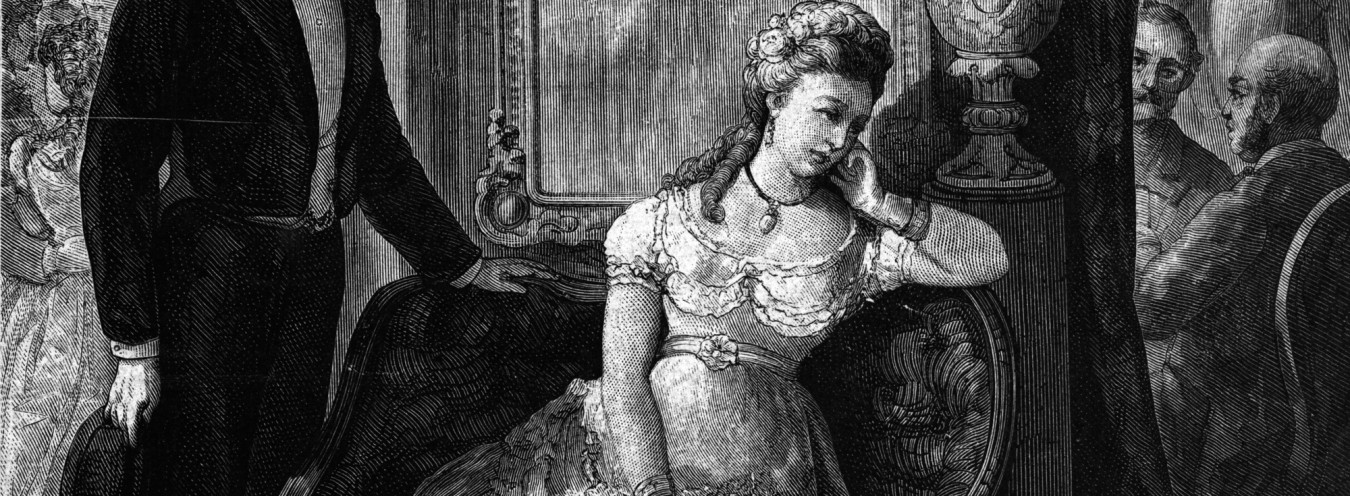
Krzeszowska, Baroness
‘[She was] a very eccentric person. She knew how to be pious and stubborn, humble and vulgar, at one and the same time …’
‘What sort of person is she, Mr Wirski?’ I asked.
‘She’s an unusual person, sir… Like all hysterical females,’ the former landowner muttered. (334)
Baroness Krzeszowska’s visit in Wokulski’s shop reveals her main characteristics: slyness, hypocrisy, and greediness as well as the desire to be in the centre of attention. Assisted by all clerks, she tries to choose one dressing-case out of a towering pile in front of her, picking, fussing, and bargaining more than any miser. Analogously, with the help of Mr Maruszewicz and a lawyer, she will later insist on the acquisition of her husband’s mare and the Łęcki house. The seemingly dignified lady, whose appearance is depicted with the use of several colours: dressed in black, with a white and yellowish face (during the second visit in the shop, she seems even paler, greener and still more sombrely dressed than the previous day), is in fact obsessed with money and has a hysteric disposition, which is trying for the people around her.
This wealthy burgher, who married Baron Krzeszowski and thus received his title and name, is not welcome in the aristocratic circles (what does she want, hateful woman – cries Izabela Łęcka). Baroness Krzeszowska’s conduct, defying the fixed conventions (e.g. watching neighbours with binoculars from her own apartment and from the one of Maruszewicz!), becomes an object of ridicule. The Baroness, referred to as an old hag, damned serpent, trollop and called devilish, does not fulfil the most important, according to contemporary customs, roles of the wife and mother. Her conduct, which not only amuses but also irritates (e.g. the criminal case against Helena Stawska for the theft of a doll, anonymous letters, constant quarrels with tenants), is a way to fulfil the emptiness after her family’s breakdown (even in her apartment, The drawing-room, boudoir, bedroom, dining room, the Baron’s room – all are empty). Although primarily perceived as a scheming stirrer, Baroness Krzeszowska is also a tragic mother, who suffers because of the loss of her daughter. This poor woman (in the eyes of Helena Stawska, also a mother) can nevertheless take advantage of her situation as a lonely and deserted person (which she does in a very theatrical way in carefully planned scenes of despair – with laments, sobbing in a heart-rending manner) to attract people’s attention. It would seem that a lonely though rich woman, who tries to gain sympathy with money, is destined to lose. Nevertheless she does not remain a loser for long. Having reconciled with her husband, who becomes her formal protector, she regains her good name and lost social position. Towards the end of the novel, Ignacy Rzecki comments on this in his diary with a surprise: Today I was shown a newspaper, in which Baroness Krzeszowska was called one of the most eminent and benevolent of our ladies, for giving two hundred roubles to some orphanage. Clearly they’ve forgotten her court case against Mrs Stawska and those squabbles with her lodgers. Can it be that her husband has broken the old hag in?
Bibliografia
- Baronowa Staffe, Zwyczaje towarzyskie, Lviv 1898.
- Świat Lalki. 15 studiów, ed. J. A. Malik, Lublin 2005.



